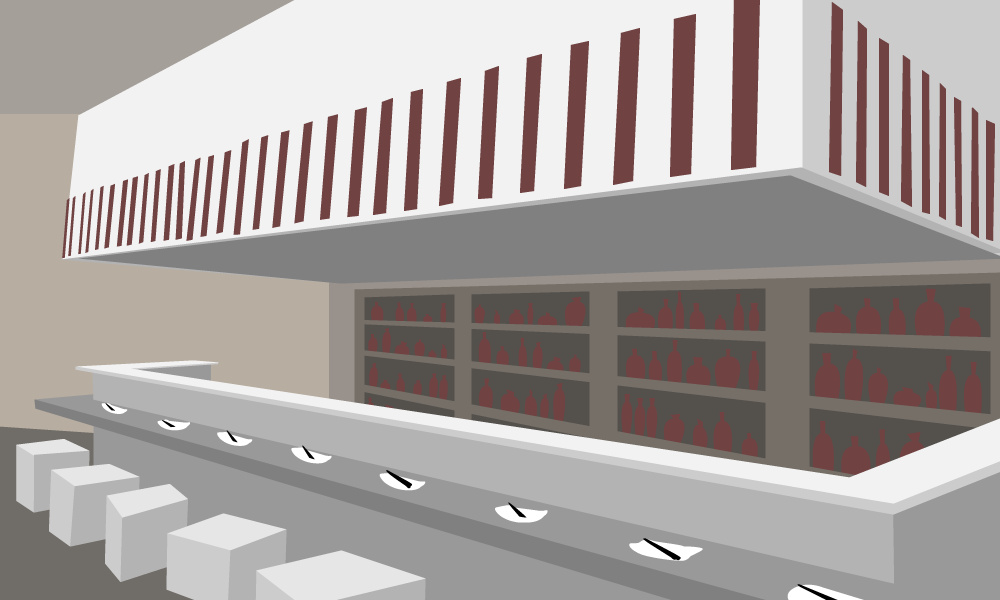My better half Rebekah and I are turning our basement into an izakaya. The reason: I’m obsessed. Also, because izakayas have a singular feel that no other social space can match, and I want perpetual access to that.
An izakaya is a Japanese bar that serves food, not the other way around. You drink while you eat a succession of small plates. Aesthetically, there is no one type, and the name izakaya is widely and vaguely applied, but the ones you commonly see in urban Japan have an aesthetic you might call “pub cluttered.” I like the way they look, stuffed with sake and whisky bottles, posters, hanging red lanterns, and people drinking at low tables made of beer crates under wooden signs whose Japanese characters could say “Hey ugly!” for all I know. Izakayas swallow you up. The clutter feels like a cozy blanket. I want to feel that at home. When the world can’t deliver, you have to make things yourself. We’re trying to make a lair, a lounge, a burrow, not a gendered “man cave,” but a cozy place to read books, listen to records, talk with friends, or be alone. And as people in Tokyo know, there are few spaces as snug as a room underground.
The few izakayas we have here in Portland serve great food and drink and a welcome slice of Japan, but they don’t have the look. They’re too clean, too Western, not sufficiently lived-in. Some have recreated part of the delicious izakaya menu, often incredibly so, but their interiors haven’t accrued the necessary layers of character, so I decided to make one myself. Not to sound arrogant. The verdict’s out; we could get it all wrong. Creating this is time-consuming, expensive, and takes commitment. We have to build the walls and counter ourselves. Then we have to fill it with the right furniture, once I find it. I’ve been gathering posters, sake barrels and banners for a year, often online using Japanese websites I can’t read and hauling stuff back from Japan, but decorating is also the fun part. The room will be badass.
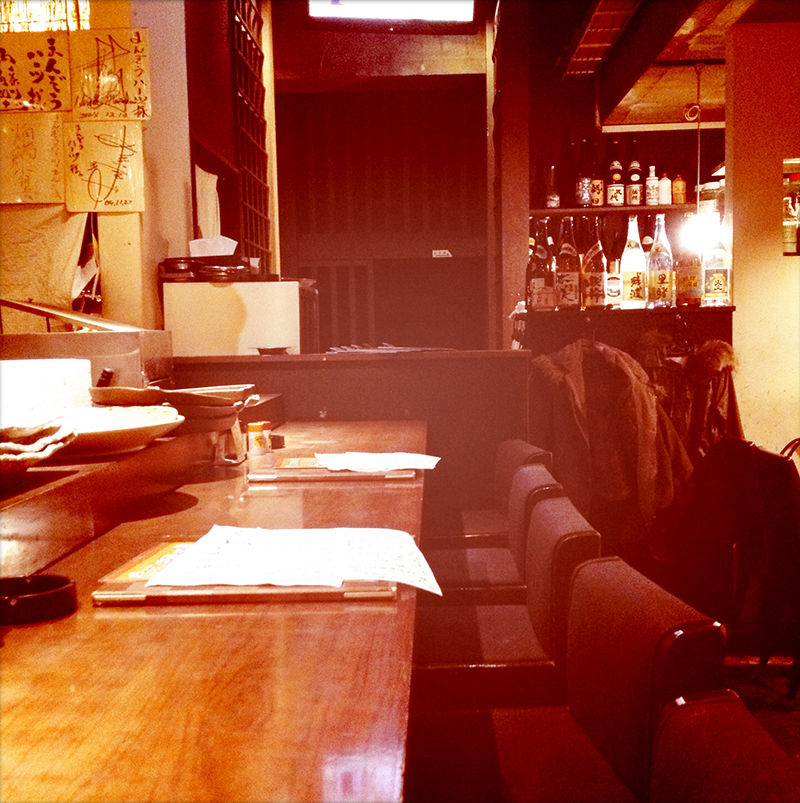
When we bought our little house, we were thrilled to see the previous owners had partially finished a third of the basement. They put drywall in one section, walling it off from the naked laundry area’s concrete floor and cement walls, and from the rickety stairs. They didn’t carpet or insulate this little room; three of its four walls are the original foundation, and moisture’s starting to bubble the paint. But with the wall, the cool powder-blue paint, and the recessed ceiling lights they installed, this sweet rectangular spot is comfortable and classy, and it’s just unfinished enough to offer a tabula rasa, ripe for development. When I first looked at it, I immediately envisioned some sort of themed room for hanging out, working out, and playing electric guitar. Not much time passed before I pictured a Japanese bar.
Izakayas are built around drinking alcohol, but they’re not drunk spots so much as social spaces where people go to spend time with each other: talking, laughing, sharing stories, processing, and forgetting about work. As Rick Kennedy says in his book Little Adventures in Tokyo, these bars “are what displaced Tokyoites are missing when they say they are homesick.” Many westerners describe izakaya food as “Japanese tapas,” which is accurate based solely on the size of the plates and act of sharing, but the comparison suggests that izakayas derived from Western tradition, and that deprives Japan of the credit it deserves. According to Chris Bunting’s book Drinking in Japan, izakayas “seem to have evolved in the 18th century out of alcohol shops that began to sell food and provide seating to customers who wanted to drink on the premises . . . ” The West didn’t invent snacks or drinking. They hold no patent on small plates. The Japanese have always been a drinking, snacking people since before the first written record of them in the second century.
A standard izakaya menu might include saba no shioyaki (grilled mackerel), karaage (fried chicken), ikayaki (grilled squid), age-dashi (cold seasoned tofu), tamago (cooked egg), gyoza, edamame, an assortment of nigiri, and maybe that comforting beef and potato stew I love so much, nikujaga. Drinks include beer, either draft or those 22-ounce bottles of mediocre mass market Sapporo or Asahi, various sakes, often what’s become the standard Suntory whisky highballs (whisky and soda), and, if you’re lucky, good Japanese whisky. But definitely beer and sake. In place of beer taps, ours will have sake, sake’s predecessor awamori, from Okinawa, and Japanese whisky. Ordering decorations on Japanese eBay using a third party is one thing, but getting the right whisky has proved challenging.
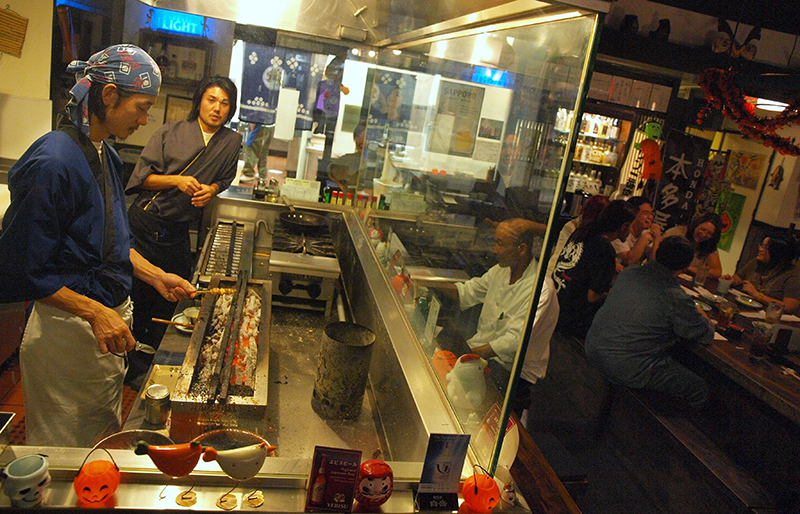
After Scotland, Japan is the second-largest producer of single-malt whisky in the world. Japanese whisky has won award after prestigious award, often beating out Scotland at the very thing Scotland pioneered. When Whisky Magazine named Nikka’s Yoichi 10 Single Cask “Best of the Best” in 2001, it shocked Western drinkers. Many didn’t even know Japan made whisky. But Japan started distilling small amounts even before Suntory’s Yamazaki distillery, outside Kyoto, launched Japan’s first true commercial whisky in 1929. That pre-WWI whisky was rough rotgut that didn’t follow Scottish or American whisky distilling techniques, because back then, producers didn’t know them. Then a young chemist named Masataka Taketsuru studied whisky-making in Scotland for two years, and the information he brought back to Japan started their modern, sophisticated industry.
The majority of Japanese single malt whisky still follows Scottish single-malt distilling methods. This means they combine 100 percent malted barley, mostly imported from the U.K., with local mountain and spring water, then distill the mash in pot stills and mature it at least three years in oak. Japanese single-malt is then moved to casks such as sherry, bourbon, brandy, and port, to impart color and flavor. Scotches typically age ten to 16 years; Japanese single-malts average ten to 18 years. Like Scotch, these single-malts are rich, wooded, and highly aromatic, and the blends producers make with these spirits, like Hibiki and Nikka Pure Malt, are just as good.
Suntory and Nikka are Japan’s two largest distillers. Other smaller modern producers include Chichibu in Saitama Prefecture, White Oak in coastal Eigashima, Kirin at the base of Mt. Fuji, and Mars Shinshū in the village of Miyada in the Japanese Alps. After a series of other high-profile awards, Western and Chinese drinkers started buying Japanese whisky in huge quantities, often at sky-high prices, and created a worldwide shortage. Liquor stores can’t keep Japanese bottles on the shelves, so the Yamazaki 12 and Hakushu 12 Western enthusiasts used to find more easily are now expensive and hard to come by. To capitalize on increased worldwide demand, many Japanese distillers started exporting a number of their blended and younger whiskies, called N.A.S. or no-age statement, on a larger scale than they did only a few years ago, including Suntory’s Hibiki Harmony, Akashi White Oak, Nikka’s Taketsuru Pure Malt, and Coffey Grain. But there are many more types that they only sell domestically. Those are the ones I want for our bar.
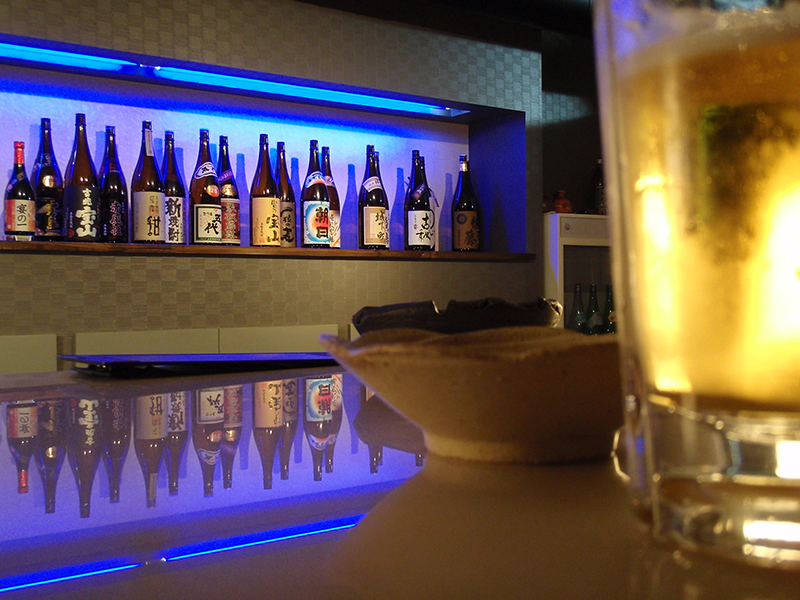
Because I started drinking Japanese whisky before the recent boom, I have some of those hard-to-find bottles at home, like Yoichi 10 and 12, Yamazaki 12, and Hibiki 12. Because I want a representative sampling of a real bar menu, I want the many common, mid- to low-tier whiskies made largely for Japan’s domestic market: the ubiquitous $11 Suntory Kakubin and $17 Suntory Old Whisky, the incredible and undervalued $10 Kirin Fuji-Gotemba, even the mediocre mixers like Suntory White Label, Hi Nikka, and Nikka Black Clear ─ basically, the Maker’s Marks of Japan. They don’t export any of these to the U.S.
Suntory’s Old Whisky isn’t actually old. It hit the market in 1950 as a luxury blend dressed up in a very English-looking package with a brown parchment label. Now you can find it at most Japanese convenience stores for under $20. Despite its no-frills reputation, I find its smooth, caramel-y flavor delicious for the price and love a little on ice in a glass.
Suntory White Label is more rough and uni-dimensional. It’s an updated version of Suntory’s first release from back in 1929. The liquor burns and has no complexity. The bottle’s better than the booze, so I use it for decoration rather than drinking.
Hi Nikka is a cheap mixer that balances grain and malt whisky with a hint of smoke. I love it. I’d drink it anytime. Dating back to 1964, the label and bottle have a cool mid-century aesthetic that add as much visual interest to a bar as the contents add to your glass. It costs 11 bucks.
Kirin doesn’t export any of its whiskies to the US, which is a shame since they’re outstanding, complex and perfect straight up for their $10 to $12 price tag.
Nikka Black Clear is just crap to put in soda, and I don’t drink soda. Then there’s Kakubin.
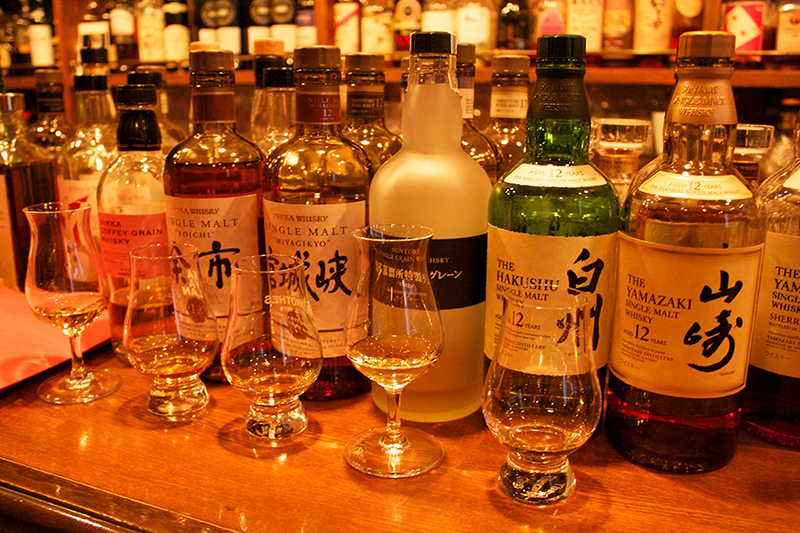
Many westerners can thank Bill Murray’s character in Lost in Translation for introducing them to Japanese whisky when he raised his glass of Hibiki and said, “For relaxing times, make it Suntory time.” But when it’s Suntory time in Japan, that frequently means Kakubin. The name might not register on many foreign drinkers’ radars, but Kakubin is Japan’s best-selling whisky. That’s because it’s a mixer, and most people in Japan drink their whisky mixed with soda or water. Kakubin translates to “square bottle.” By heavily marketing Kakubin as the main ingredient in the Suntory Highball, Suntory has built Kakubin into one of the foundations of Japanese drinking culture and made its clear, tortoise-shell bottle and round yellow label as central a visual component in Japanese bars as cigarette-smoking salarymen. Visitors will find Kakubin at any corner convenience store. They’ll find bottles of it in grocery stores. In addition to the classic, original yellow label, Kakubin comes in Kabukin Black, which is stronger tasting and higher in alcohol, and Kakushiro White, which is light and floral. In an increasingly complex industry whose craftsmanship and flavors have grabbed the drinking world’s attention, Kakubin offers a nice simple dram that neither disappoints nor blows your mind. Unfortunately, Americans can’t find it in their country.
Although Suntory does export Kakubin to Australia and the U.K., online retailers’ hefty international shipping fees turn that $11 dollar bottle into a $100 bottle and make my eyes roll. Scarcity makes it the forbidden fruit whose flavor isn’t worth the price. It also puts it in that privileged category of Japanese experiences you can only enjoy on vacation: real yakitori, Hiruzen Jersey yogurt, cod roe-flavored perilla pasta sauce, and Kirin Ichiban Shibori frozen black beer. Maybe it’s better that way. When traveling, it’s nice to have a treat to look forward to. I still want about ten bottles of it, though.
And let’s be straight. None of these domestic whiskies are fancy. Telling hardcore Japanese whisky enthusiasts you like Suntory Old Whisky and Hi Nikka is a surefire way to undermine your credibility. Although delicious on its own, fans of Highland and Islay whisky will find Kakubin’s nose light, finish short, and body simple. It isn’t meant to compete with the richness of Nikka’s Miyagikyo whisky or the crisp, forest flavors of Suntory’s Hakushu. But it’s everywhere in Japan, and that bottle is really striking. Some izakayas stock their shelves with bottles of Kakubin three or five deep, so we will, too, if we can get them. This is where things get challenging.
Laws restrict the personal, non-commercial importation of liquor from Japan by post. Yes, you can buy some Japan-only whiskies yourself and carry a certain amount home on the plane, declaring them at customs and paying any duties that customs officials may or may not request. But Japanese online retails can’t ship their whisky to the U.S. Japanese citizens cannot legally mail bottles of whisky to their American friends, and if you as a gaijin traveler mail bottles home from Japan, you have to lie on the paperwork and say there’s no alcohol in the packages. In a notoriously rule-abiding nation, that isn’t cool, but it is an option.
On Rebekah’s and my honeymoon, I bought a bunch of whiskies you can’t find in the U.S. and hauled a total of nine large bottles in my checked luggage, which I declared at customs. On a previous trip, before I knew better, I mailed a few small airplane bottles home, packed inside a box of gifts and canned fish. I would never (never) do that now. What this means is that I have a nice mix of the available and unavailable, from the new no-age statement Yoichi and Miyagikyo to Chichibu Malt & Grain. On our honeymoon, I nabbed some unusual ones like Yamazakura Cherry Ex. I got the Japan-only, Meiji-era artifact called Denki Bran. Invented in 1882 to replicate brandy, its name translates to “Electric Brandy,” and it contains a secret mixture of brandy, gin, curaçao, wine, spices, and herbs. Its mystique is stronger than its flavor. I got the bedrock grocery store mixers Suntory Torys Honey, Suntory White Label, and Suntory Old Whisky, and of course I got the essential Kakubin yellow, black, and white labels. These everyday drams taste good enough, but their bottles and everyday, average-Joe character make them more valuable to me. The sight of their labels floods me with good memories of Rebekah’s and my time together on the other side of the ocean, and by building our basement bar around them, we might actually succeed at recreating some of that izakaya feel.
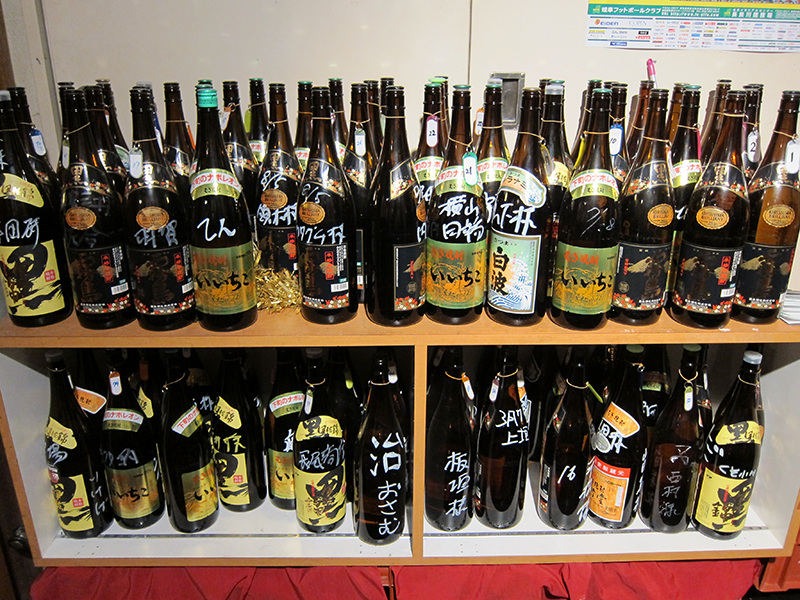
A friend brought me a bottle of Kakubin back from Japan. I’m still on the hunt for others common in Japan but not exported anywhere, like Kirin Fuji-Gotemba, so I’m trying to find a way to fly back to Japan one more time specifically for whisky. I know that’s extreme. I admit I’m obsessed. But in addition to wanting an excuse to go back to Japan for any reason, I’m going for authenticity, so the rule is: If they do it one way in Japan, we’re doing it that way in our bar. Authenticity is bankrupting me, but it’ll be worth the trouble.
My focus on whisky over food might make our basement more of a nomiya than izakaya. Nomiya means “drinking place” ─ a pub, basically. In Drinking in Japan, Chris Bunting writes that “The words sakaba and nomiya seem to have slightly wider ranges of meaning than izakaya, encompassing bars without the food menu you would expect in an izakaya, but there is no reliable definition.” If I was going for gold, I’d get a rice cooker and hot tray for keeping my homemade nikujaga beef potato stew down there when we have guests; it and grilled fish are the only Japanese dishes I make well. And I’d get a Zojirushi hot water kettle for tea eventually, too, if I could save up the money; they aren’t cheap. But we have a water kettle upstairs, and our regular fridge is stocked with beer and all the usually crap, so visitors can grab some of that, so no need to make ours a place to eat and chill. I know this is getting complex and sounds like a pitch to investors. To be clear, we aren’t starting a business. We’re just decorating to resemble the real deal. And because I’m going for ambiance over alcohol, I’m going to mix in elements of my other favorite Japanese institution: the jazu kissa, or jazz coffee shop. Like izakaya, jazz kissas’ interiors can be comfortably cluttered, their walls layered with mid-century record sleeves, concert posters, cat statues, and the personal ephemera of decades. I love them. So I’m basically mashing together the look of an izakaya with the music and look of a jazz kissa and the stock of a whisky bar. What does that make this, a jazu kissakaya-nomiya?
I’m only telling you this because I’m excited.
After the whisky comes the decor. Rebekah and I have filled three cases with our books down there, and I’ve been stockpiling empty Japanese beer bottles, cans, and signs for the walls. I have a wide range of Japanese beer and whisky glasses to use. I ordered poster-sized whisky advertisements from Japanese eBay. I’ve collected little decorations like postcards, cat textiles, and key chains to dangle from things, and Japanese cardboard produce boxes to shove in the corners for flair. It’s the little things that bring a place to life. Also, Asahi beer crates. You have to have plastic Asahi beer crates. They’re everywhere in Japan. Stores keep empty 22-ounce bottles in them for pickup. Sake and Sapporo bottles have their own crates. Many izakayas stack two or three crates and set a table top on them, along with condiments, chopsticks, and shoyu, then either use low stools or other overturned crates for seats. You can’t find these in the U.S., so late one night in Osaka, I went out on a solo mission to lift two yellow Asahi crates from the busy streets of Dotonbori and mail them home.
Rebekah had passed out early. She slept deeply in Japan. She was making up for all the sleep we don’t get back home. She also loved the futons. Stealing from a foreign country would stress her out too much, which would stress me out, and I needed to remain stealthily calm. So as she snoozed, I went alone, searching for my plastic prey and soaking up the Osaka nightlife. I stole the first crate from a dark alley next to a Korean restaurant, which required removing two beer and Coke bottles and setting them on a different crate. I found my second crate on the sidewalk behind a sandwich board not near any restaurant. It was as if it was meant for me ─ or so I told myself. I felt guilty stealing from such a friendly, honest country as Japan, but I wanted the crates more than I wanted to feel good about myself. So on an extremely crowded street in front of tons of people, I picked up the crate and carried it blocks and blocks through hordes of pedestrians, all the way back to the hotel, without shame. Everyone was drunk and smoking or doing their own thing, seemingly unconcerned, if they even saw me at all. I saw no disapproving expressions on their faces, though my expression was internal: I was so excited to have these crates! I’d waited a year to get them, stupid as that was.
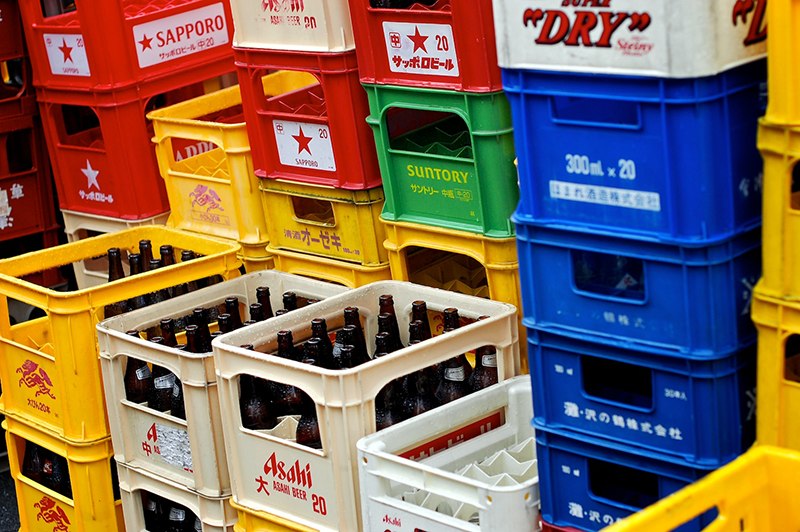
Rebekah didn’t budge when I slipped into the hotel room to drop off the first crate. Her hair spilled from under the comforter exactly as it had when I’d left. She roused when I came in the second time at 11:40. “Everything okay?”, she said.
I peeled off my shoes in the dark. “Everything is very okay,” I said before crawling into bed. Every night is Saturday night in this part of Osaka. I could live there. Instead, I was trying to take part of it home.
After we repacked our luggage and cleaned our hotel the next morning, I packed all my empty cans and new Japanese stuff into big cardboard boxes that I got from some guys unloading produce down the street, wrapped all the empty beer cans and bottles I’d collected for our bar in bubble wrap, then padded them with socks, taped them up tightly, and we carried them to the Post Office. It was comically difficult. We spent an hour at the P.O. filling out forms, describing the contents to three different clerks and failing to understand each other. “Crate,” I said desperately, “crate. Box. Um, container.” I reached through a hole in the box and tapped the plastic crate. “Crate. For birru.”
The high-ranking clerk leaned over the counter, studying the form I’d filled out and trying to understand what was in these cardboard boxes. “Crate,” he said over and over. “Crate. Hmmm.” He tilted his head. “Crate?”
My phone wouldn’t get a signal, so Rebekah used Google translate to find the Japanese word for crate. “Kibako,” I said. “Asahi kibako, for birru. Asahi beer.”
“Ah, Kibako,” he said nodding. “Crate. Kibako, kibako,” and filled in the form.
“Yes,” I said proudly, “kibako for birru.” With a sense accomplishment, I stood up straight, relieved how we got through this difficult transaction and that these crates might finally make it safely over the Pacific Ocean.
The clerk’s face turned sour. “Ah, birru,” he said shaking his head. You aren’t supposed to mail beer. He looked up from the form, clutching the pen in his hand. “Birru?”
I assured him, “Birru empty. Cans. Bottles. No birru. Eto —”
Rebekah held her phone in front of my face. “Karappo,” I said. “Karappo? Empty. Is that right?”
The clerk smiled and nodded. “Karappo birru! Yes, I see.” We laughed as he wrote what I assumed was the Japanese phrase for “empty can” on the form next to the English phrase, or possibly the phrase “gaijin with empty head.”
Now that we’d figured out a system, Rebekah Googled the names for the rest of the items on the list, including “salt,” “can” (for canned fish), “towel,” “bottle” and “shirts.” That made the difference.
We went through them all: the dekiru of cooked sanma and iwashi, the tīshatsu, jars of bonito dashi, and Creap brand coffee creamer, because the name Creap is hilarious. But about those beer bottles and cans ─ he held up a small soda can that stood on the counter and pantomimed pouring it upside down. “Empty, empty.”
“Yes,” I said, “empty.” That was only partly true. One box contained four airplane bottles of whisky, and one large 750ml one. I couldn’t help myself. I wanted this whisky! Besides that, though, the beer cans were empty. I felt guilty. First, stealing the crates, then lying about the whisky. The Japanese people were so patient and helpful to visitors. They went out their way to make you feel welcome and find what you needed, especially when you got lost. This man was patient, and I looked him in the eye and lied to him. I was a jerk, but these are the lengths the obsessed go through to get what they need to create their basement izakaya.
He muttered okay, okay, and calculated the price based on weight. Japan Post offers three overseas shipping methods: air, S.A.L., and surface. I chose surface, the cheapest. It cost $40 for the crate full of empty beers, and $50 for the other box of whisky, food, and miscellany. That was a big commitment.
Rebekah and I walked out of there after an hour and looked at each other. “Well, that took some effort,” I said apologetically. She smiled and shuffled down the street. “Thanks for being so patient. I know I’m nuts. You’re a total champ.”
“You’re welcome,” she said, and draped her arm around my shoulder. She’d hung in there because she knew it mattered so much to me, her insane, obsessed husband, just as crazy on the other side of the planet as at home. And maybe because she knew the basement would be awesome with this stuff in it. As a show of gratitude, I vowed not to drag her back to the P.O. She assured me she wouldn’t go back there even if I asked. To me, it was worth the trouble. Besides memories, whisky was one of the things I wanted to bring back the most. That and sencha and these crates. Avoiding the P.O. meant I had to keep my second Asahi crate in my luggage for a week, with all the new empties I collected and full bottles of whisky inside, and my clothes wedged on top and all around it. When I mailed it home from Kyoto, I did it by myself .
The three boxes took nearly two months to arrive. Their contents survived intact, no damage or dings.
To some, the comprehensive intensity of my vision will look indulgent, and I’m okay with that. You don’t embark on these sorts of projects if you have all your marbles. Sanity is constrictive. But none of these details matter if you don’t have the bar, and we still have to build the bar.
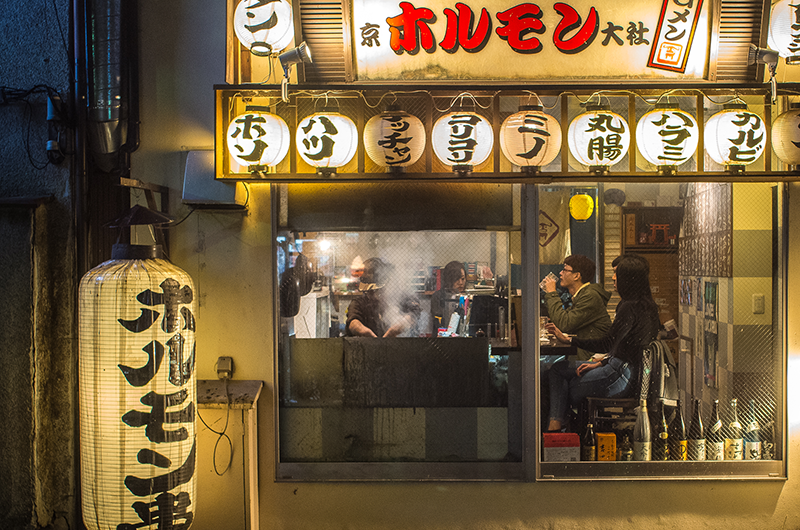
First, we need to line the three exposed concrete walls with insulation and drywall. That’ll keep out moisture and allow us to attach shelves, cabinets, a table, and lamps and hang all the posters, then we’ll build the simple bar counter itself. Once we mount some wall speakers, we’ll set a record player down there stocked with my old jazz records (and Iggy and the Stooges, Neil Young, etc.), hang a cheap flat screen in the corner, and use the space as a media room to watch movies. Because I can’t afford to pay someone to do the work for us, and because I have little construction experience, we’re paying a skilled friend “to help me do it.” (Meaning I’ll assist him.) Then the fun begins. Until then, I keep stockpiling decorations for the bar that isn’t there.
The funny thing is, I don’t even plan to drink as much as hang down there. I want the atmosphere. When I’m tired of America and the familiar sight of my city’s wide streets, tired of the way the our roofs slant and restaurants look and trees are spaced, I want to be able to go downstairs and slip into a little authentic piece of Japan, fully immersed, and disappear. I do plan to read a lot beside my library, and I plan to use the bar counter as a standing desk to write. When you work a lot from home, you need variety. You can’t just use your one office chair. Don’t get me wrong. I love my beer, and I love whisky. Some of the Japanese spirits I bought are my favorite of all, but the bottles mean as much to me as the drams. The sight of them keeps our honeymoon alive and help me build the dream, and when I’m at home, living my routine life between ecstatic vacations, I’m all about the dreams. •
Feature image created by Shannon Sands. Images courtesy of throgers, Yamanaka Tamaki, dvalinlegris, Vincent Diamante, Yuya Tamai, jit bag, and David Lanham via Flickr (Creative Commons)
